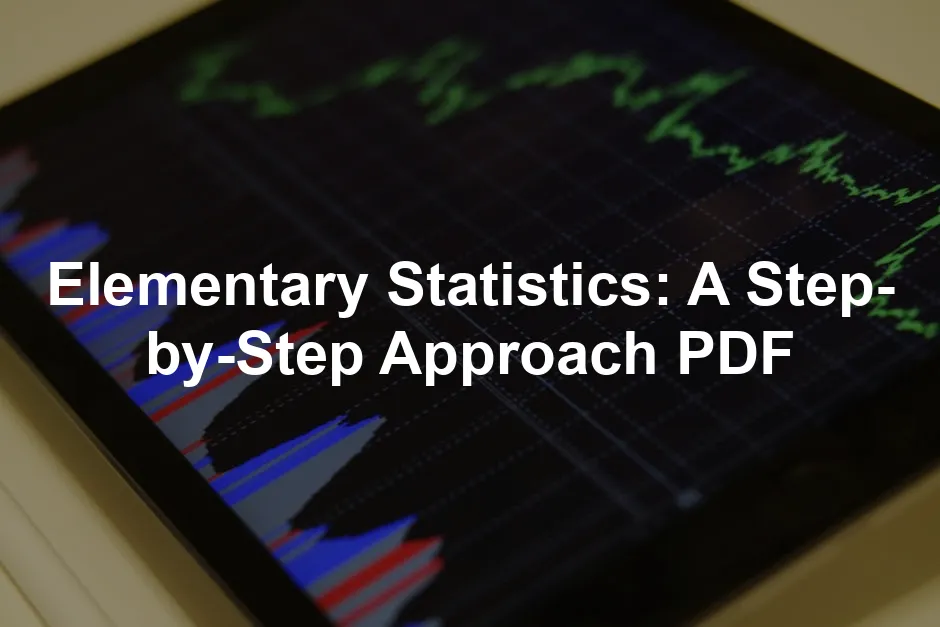Introduction
Elementary statistics can seem intimidating. But fear not! It’s a vital tool used across various fields, including social sciences, business, and health. Whether you’re analyzing survey results or predicting market trends, statistics help make sense of data. Understanding these concepts can transform you from a confused novice into a confident data analyst.
So, what’s the deal with the “Step-by-Step Approach” by Allan Bluman? This methodology breaks down complex statistical concepts into manageable chunks. It’s designed for anyone—students, professionals, or just curious minds wanting to grasp the essentials of statistics. Bluman’s approach empowers readers to tackle statistical challenges with confidence.
Looking for an easy way to access this treasure trove of knowledge? The PDF version of “Elementary Statistics: A Step-by-Step Approach (10th Edition)” is available for download! This makes it perfect for self-study at your own pace. With this resource, you can learn the ropes of statistics anytime, anywhere. So grab your favorite beverage, cozy up, and let’s get statistical!

Understanding Elementary Statistics
What is Elementary Statistics?
Elementary statistics is the foundational study of data collection, analysis, interpretation, and presentation. It covers essential concepts like measures of central tendency (mean, median, mode) and measures of dispersion (range, variance, standard deviation). These concepts lay the groundwork for understanding more complex statistical methods. For more insights on the importance of understanding statistical concepts, check out this article on an introduction to statistical learning with Python.
In real-world applications, elementary statistics proves invaluable. For instance, businesses rely on statistical data to enhance marketing strategies. A healthcare provider might analyze patient data to improve treatment methods. Even your favorite social media platform uses statistics to tailor your feed. Without a solid understanding of these concepts, making informed decisions becomes a gamble.

Importance of Statistics in Everyday Life
Statistics play a significant role in our daily decisions. Every time you check the weather forecast, you’re looking at statistical models predicting rainfall. When you choose a new restaurant, you might glance at customer reviews and ratings—again, statistics at work!
Consider marketing as another example. Companies analyze consumer behavior through surveys and sales data. This analysis guides them in crafting effective advertising campaigns tailored to their target audience. In healthcare, statistics help track disease outbreaks and determine the effectiveness of treatments.
In short, understanding statistics isn’t just for math enthusiasts. It’s a crucial skill that enhances decision-making in everyday life. From business to health, statistics shape the world around us, making it essential for everyone to grasp these fundamental concepts.

Overview of the “Step-by-Step Approach”
The “Step-by-Step Approach” by Allan Bluman is all about making statistics approachable. It emphasizes understanding concepts through practical examples. Instead of drowning in abstract theories, students can see statistics in action. This method is perfect for those who learn best through real-world applications. It’s like having a friendly guide leading you through the maze of data.
This approach benefits students and self-learners in several ways. First, it breaks down complex topics into bite-sized pieces. Each chapter builds on the last, helping learners grasp foundational ideas before moving on. This scaffolding technique supports students, reducing overwhelm and boosting confidence.
Moreover, practical examples demonstrate how statistics apply in everyday scenarios. From analyzing sports statistics to understanding health data, the real-world relevance keeps learners engaged. It shows that statistics are not just numbers; they’re tools for making sense of life. Overall, Bluman’s method equips readers with the skills needed to tackle statistical challenges confidently.

Key Concepts of Elementary Statistics
Descriptive Statistics
Descriptive statistics summarize and present data in a meaningful way. They provide a snapshot of a dataset, helping you understand its main features without diving into complex analysis. This section covers two critical aspects: measures of central tendency and measures of dispersion. For a comprehensive guide on this topic, refer to descriptive statistics in manufacturing plant.

Measures of Central Tendency
Measures of central tendency include the mean, median, and mode. These measures help identify the center of a dataset, giving insight into its overall behavior.
– Mean: This is the average of all values. You calculate it by adding all numbers and dividing by the count. For instance, in a dataset of test scores (80, 85, 90), the mean is (80 + 85 + 90) ÷ 3 = 85.
– Median: The median is the middle value when numbers are arranged in order. If there’s an odd number of observations, it’s straightforward. For example, in the dataset (70, 80, 90), the median is 80. However, if you have an even number of observations (70, 80, 90, 100), the median would be (80 + 90) ÷ 2 = 85.
– Mode: The mode represents the most frequently occurring value. In the dataset (70, 80, 90, 90), the mode is 90 because it appears twice.
Each measure has its importance and specific scenarios in which it shines. The mean is useful for normally distributed data. The median is great for skewed distributions, as it isn’t affected by outliers. The mode is excellent for identifying trends in categorical data. Knowing when to use each measure can enhance your statistical analysis.
Measures of Dispersion
Measures of dispersion complement measures of central tendency by showing how spread out the data is. They help you understand data variability, which is crucial for making informed decisions.
– Range: This is the difference between the highest and lowest values. For example, in the dataset (10, 20, 30), the range is 30 – 10 = 20. It gives a quick sense of how spread out the data is. For a deeper dive into crime statistics, see this link about orange county ca crime statistics.
– Variance: Variance measures how far each number in the dataset is from the mean. The formula involves finding the average of squared differences from the mean. For a dataset with values (4, 8, 6), the mean is 6. The variance is calculated as follows: [(4-6)² + (8-6)² + (6-6)²] ÷ 3 = 2.67.
– Standard Deviation: This is simply the square root of the variance. It provides a measure of dispersion in the same units as the data. In our previous example, the standard deviation is √2.67 ≈ 1.63.
By understanding these measures, you gain insights into data variability. High variance or standard deviation indicates a wide spread of values, while low values suggest that the data points are close to the mean. This knowledge is crucial when evaluating the reliability of your data.
In summary, descriptive statistics lay the groundwork for understanding data. Measures of central tendency help identify the center, while measures of dispersion reveal how data points vary. Together, they provide a comprehensive view of any dataset, preparing you for deeper statistical analysis.

Probability Basics
What is Probability?
Probability is the measure of uncertainty. It’s a way to quantify how likely an event is to occur. In statistics, probability helps us make predictions and informed decisions based on data. It’s like having a crystal ball that isn’t entirely clear, but still offers insights into the future!
The significance of probability in statistics can’t be overstated. It forms the backbone of many statistical concepts. Without a solid grasp of probability, understanding statistics is like trying to complete a puzzle with missing pieces.
Some basic probability rules include:
– The probability of an event ranges from 0 (impossible) to 1 (certain).
– The sum of probabilities of all possible outcomes equals 1.
– Independent events have probabilities that don’t affect each other. For example, flipping a coin doesn’t change the odds of rolling a die.
Understanding these rules lays the groundwork for further statistical exploration.

Probability Distributions
Probability distributions describe how probabilities are assigned to different outcomes. They’re essential in statistics because they model real-world phenomena. Three common types are normal, binomial, and Poisson distributions.
1. Normal Distribution: Often called the bell curve, this distribution is symmetrical. Most values cluster around the mean. It’s used in numerous fields, from psychology to finance. For example, test scores often follow a normal distribution.
2. Binomial Distribution: This distribution applies to situations with two possible outcomes, like success or failure. Think of flipping a coin a set number of times. It’s widely used in quality control processes and survey results.
3. Poisson Distribution: This distribution models the number of events occurring in a fixed interval of time or space. It’s handy in fields like telecommunications, where you might measure the number of calls received at a call center in an hour.
By understanding these distributions, you can analyze various situations and make informed decisions based on data. They provide a framework that helps predict outcomes, assess risks, and understand variability in data.

Inferential Statistics
Hypothesis Testing
Hypothesis testing is a method used to make decisions based on data. It involves formulating a hypothesis and then determining whether the data supports it. This process is crucial in research and decision-making. For a detailed guide on this topic, refer to the statistics hypothesis testing cheat sheet.
In hypothesis testing, you start with a null hypothesis (H0), which states there is no effect or difference. The alternative hypothesis (H1) suggests there is an effect or difference. Through statistical tests, you evaluate whether to reject H0.
Understanding the types of errors is essential in this process.
– Type I Error: This occurs when you reject the null hypothesis when it’s true. In simpler terms, it’s a false alarm—thinking something is happening when it’s not.
– Type II Error: This happens when you fail to reject the null hypothesis when it’s false. Here, you miss out on detecting an actual effect.
Significance levels (commonly set at 0.05) help determine how extreme the data must be to reject the null hypothesis. Setting the right significance level is vital. It balances the risks of Type I and Type II errors, ensuring your conclusions are both reliable and valid.
Hypothesis testing is a powerful tool in statistics. It guides researchers in making sound decisions backed by data, whether in scientific studies, business strategies, or policy-making. So, the next time you hear about a research study, remember: hypothesis testing is the magic behind the curtain!

Confidence Intervals
Confidence intervals are a key concept in inferential statistics. They provide a range of values that estimate a population parameter. Think of them as a statistical safety net. They offer insights into how confident we are about our estimates.
When you collect data, you often want to make predictions about a larger group. For instance, if you survey 100 people about their favorite ice cream flavor, you might want to know the preferences of all ice cream lovers. This is where confidence intervals shine!
A confidence interval is usually expressed as a percentage, like 95% or 99%. A 95% confidence interval means that if you were to take 100 samples, about 95 of them would contain the true population parameter. It’s like saying, “I’m pretty sure the real average is somewhere in this range, but there’s a small chance I could be wrong.”
Calculating a confidence interval involves a few steps. Let’s say you want to estimate the average height of adult males in your city. You collect a sample of 50 men and find an average height of 175 cm with a standard deviation of 10 cm.
To calculate the 95% confidence interval, you use the formula:
[ Confidence Interval ] = Sample Mean ± ( Z × Standard Deviation / √n )
Here, “Z” is the Z-score corresponding to your confidence level (1.96 for 95%), and “n” is your sample size.
Plugging in the numbers:
[ CI ] = 175 ± ( 1.96 × 10 / √50 )
This gives you:
[ CI ] = 175 ± 2.77
So, the 95% confidence interval is approximately (172.23, 177.77). This means you can be 95% confident that the average height of all adult males in your city falls within this range.
Interpreting confidence intervals is crucial. For our example, if someone asks about the average height, you can confidently say it’s between 172.23 cm and 177.77 cm. If the interval is narrow, it indicates that your estimate is precise. A wider interval suggests more uncertainty.
In summary, confidence intervals are essential for making informed decisions based on sample data. They help quantify uncertainty and provide a clearer picture of the data you’re analyzing.

Resources for Learning Elementary Statistics
Recommended Textbooks and PDFs
When it comes to mastering elementary statistics, having the right resources is crucial. Here are some notable textbooks, including the highly acclaimed “Elementary Statistics: A Step-by-Step Approach (11th Edition) by Allan Bluman. This book simplifies complex concepts, making them accessible for everyone.
1. Elementary Statistics: A Step-by-Step Approach (10th Edition)
Author: Allan Bluman
Download PDF
2. Elementary Statistics: A Step-by-Step Approach (11th Edition)
Author: Allan Bluman
Download PDF
3. ISE Elementary Statistics: A Step by Step Approach – A Brief Version
Author: Allan G. Bluman
Download PDF
4. Elementary Statistics Textbook PDF
Download PDF
These resources are essential for building a solid foundation in statistics. They provide clear explanations, practical examples, and exercises to reinforce your understanding.

However, it’s important to ensure that you access these materials legally. The links provided lead to reputable sites where the PDFs are either free or available for purchase.
With these textbooks at your fingertips, you’ll be well on your way to mastering elementary statistics. Happy learning! You might also want to consider grabbing a copy of Statistics for Dummies for an easy-to-understand introduction!
Online Courses and Tutorials
The world of statistics is just a click away! Numerous online platforms offer fantastic courses tailored to help you grasp statistical concepts. Coursera is a popular choice, featuring courses from renowned universities. Courses like “Statistics with R” or “Business Statistics” can elevate your skills.
Khan Academy provides a treasure trove of free resources. Their statistics section includes engaging video tutorials and practice exercises that are perfect for beginners.
YouTube also has a wealth of content. Channels like StatQuest with Josh Starmer break down complex topics into bite-sized pieces, complete with fun visuals. If you prefer a more structured approach, check out Crash Course Statistics, which delivers engaging lessons in a lively format.

Practical Applications and Tools
Statistics aren’t just theoretical—they have practical applications! Familiarizing yourself with software tools can enhance your statistical learning. Excel is a user-friendly option for beginners. Its functions help you perform basic calculations and create graphs easily. Plus, why not grab a copy of Excel 2021 for Dummies to get started?
For those eager to dive deeper, R and Python are powerful programming languages commonly used in statistics. R is particularly popular among statisticians for its extensive libraries and visualization capabilities. Python, with libraries like Pandas and NumPy, is ideal for data analysis.
Practice makes perfect! Consider working with real datasets available on platforms like Kaggle or UCI Machine Learning Repository. These resources provide datasets across various fields, allowing you to apply your statistical knowledge in real-world scenarios. Statistical software like SPSS or Tableau Your Data! can also help visualize and analyze data effectively.

Conclusion
In summary, understanding elementary statistics is a gateway to making informed decisions in both academic and professional settings. We’ve explored the foundational concepts, practical applications, and resources available to help you on this journey.
Statistics is not merely about numbers—it’s about interpreting data to unveil insights. Whether you’re crafting marketing strategies, conducting research, or making everyday decisions, a solid grasp of statistics serves as your compass in navigating the data-driven world.
So, why not take the plunge? Dive into the resources we’ve provided and continue your statistical learning adventure. Remember, every expert statistician started somewhere. With the right tools and determination, you can transform into a confident data analyst, ready to tackle any challenge that comes your way! Don’t forget to check out Naked Statistics: Stripping the Dread from the Data for a witty take on the subject!

FAQs
What is the main focus of “Elementary Statistics: A Step-by-Step Approach”?
The primary focus of “Elementary Statistics: A Step-by-Step Approach” is to provide readers with a practical understanding of statistical concepts. It emphasizes real-world applications, ensuring learners can apply what they learn to various fields.
Where can I download the PDF version of “Elementary Statistics: A Step-by-Step Approach”?
You can find the PDF version of “Elementary Statistics: A Step-by-Step Approach” on several platforms. For the 10th edition, visit Scribd. For the 11th edition, check out this link. Always ensure you access these resources legally.
Is prior knowledge of statistics required to use this textbook effectively?
No prior knowledge of statistics is required! This textbook is designed for beginners. It starts with the basics and gradually introduces more complex concepts. Even advanced learners can benefit from its structured approach and practical examples.
How can I apply elementary statistics in my career?
Elementary statistics is essential in various careers. For instance, marketers rely on data analysis to understand consumer behavior and tailor campaigns. In healthcare, professionals use statistics to analyze patient data and improve treatment methods. Additionally, researchers across fields apply statistical methods to validate findings and draw conclusions.
Are there any free resources for learning elementary statistics?
Absolutely! Free resources are abundant. Websites like Khan Academy offer comprehensive statistics courses at no cost. YouTube channels like StatQuest and Crash Course Statistics provide engaging video content. Moreover, you can access free e-books and PDFs through platforms like Project Gutenberg and Open Library.
Please let us know what you think about our content by leaving a comment down below!
Thank you for reading till here 🙂
All images from Pexels




